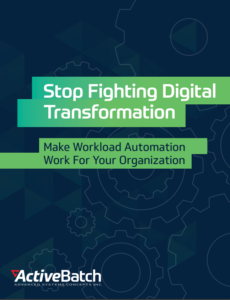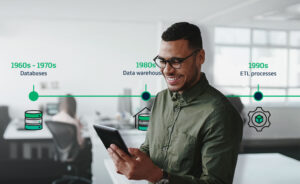Transforming I&O to Keep IT Ahead of Digital Business
I&O must leverage technologies such as hyperautomation, AI, intelligent monitoring, and orchestration. Here’s what it takes to stay ahead of business needs.

What is I&O?
IT I&O is shorthand for IT infrastructure & operations, two related segments that support everything else IT might be responsible for (software development, help desk, communications etc.). In many cases, especially with small- to mid-sized organizations, I&O might encompass the entire IT department, so the terms are often used interchangeably.
That said, infrastructure and operations are not interchangeable, so let’s get that cleared out of the way.
IT infrastructure teams manage the physical and virtual assets that support networking, processing, and storage. This includes on-premises data center hardware such as servers, power and cooling elements, and networking devices, as well as virtualized data center environments.
IT operations teams, on the other hand, are in charge of designing, setting up, configuring, deploying, and then maintaining technologies that directly support the business. IT operations teams deliver services and applications to line-of-business customers as well as external customers.
Roles and Structure of I&O
IT infrastructure and operations teams traditionally adhere to the standard structure used by most organizations –employees report to directors who lead independent teams or departments, and the directors report to a leadership-level position such as a VP, who has the final say.
As an example, a CIO might oversee an IT operations team that includes IT directors in charge of the operations management team, the operations analytics team, the application management team, plus a team of developers.
But as we’ll cover in a moment, the traditional structure of I&O organizations is beginning to change as these teams adapt to new market pressures and business demands.
Traditional I&O Strategies Are No Longer Enough
Digital technologies have rapidly evolved over the past two decades. In 2005, few people were talking about cloud computing, AI was still an academic project, and the smartest phone was a Blackberry.
As these technologies have evolved, so too have consumer expectations. Customer service calls need to be promptly answered, if chatbots aren’t available; retail items must be available online, and user information, bank accounts, insurance quotes, car services, etc., must be immediately available on our smartphones. If a server or a database experiences an issue, the financial impact is immediate.
As a result of changing consumer expectations, technological advancement, and evolving business models, I&O departments have become far more central to business strategy and long-term initiatives.
In order to remain competitive, I&O can no longer be regarded as a support function or supplier to the business, but rather as a key partner in innovation and long-term growth. By elevating I&O’s role within the organization, I&O leaders can more closely coordinate and cooperate with business leaders to develop innovative new products and services.
Aligning I&O with business goals is critical to staying ahead of competition. Technologies and markets are evolving quickly, and I&O teams must be able to shift focus quick enough to keep pace with business demands. This requires that I&O teams rethink organizational structure and the configuration of IT environments.
How I&O Can Prepare for Continuous Digital Transformation
If only Blockbuster had built a video streaming service before Netflix.
Businesses that successfully capitalize on new technologies find themselves with a tremendous leg up on their competitors. Those that take too long to get on board with, say, mobile app development, set themselves far behind in the market.
The major paradigm shift that has taken place in the past 10 years is in how organizations (specifically in software) regard the products and services they provide. If anyone remembers Facebook in 2009, it looks nothing like it does today. Facebook, like every other application and software product, has gone through countless iterations.
In order to meet evolving business needs, I&O teams need to take a similar approach of continuous development when working towards business goals. Instead of operating with a project mindset, I&O teams need to operate with a product mindset. The difference is that a project has a clear, defined point of completion whereas a product is continuously improved.
Don’t let IT complexity hamper your digital goals
Get the latest trends and data on what’s driving transformation and how IT teams address these challenges.
The New I&O
When I&O aligns with business goals, I&O’s ultimate customer becomes the business’s external customer. And when I&O is serving the external customer, I&O needs to get agile –continuous integration and continuous development (CI/CD), infrastructure-as-code, shift-left automation, and DevOps each has its place in a modernized I&O department.
Furthermore, as I&O begins to implement a customer-centric approach, it will need to address the way employees coordinate and collaborate. I&O professionals will need to be able to work across functions, teams, and departments (and with line-of-business teams), as needed, to develop, release, and iterate products and services required by the business.
This doesn’t mean that projects will ever completely disappear –someone will still have to update the Oracle servers. But that update will be a deliverable in support of the final product.
What these changes look like will depend on the organization. Perhaps an IT director still needs daily meetings with his operations team, or perhaps team members will be assigned to a variety of products, each with its own lead. Maybe self-organizing teams will work best.
Whatever the changes, they should be rolled out slowly, in phases, and not all at once.
The Right Tools for Modern I&O
I&O environments are increasingly disparate and distributed. Traditional data centers are giving way to virtualization and cloud services, and the idea of the IT specialist is giving way to the IT versatilist who has experience working with a broad set of technologies. But this skill set can be difficult to come by, even harder to retain, leaving I&O teams to wrestle with complex ecosystems and brittle integrations.
In order to streamline the delivery of data across complex, hybrid and multi-cloud environments, I&O teams should develop a technology base that covers these five concerns:
- Intelligent Automation – Sometimes referred to as hyperautomation, intelligent automation leverages artificial intelligence and machine learning to rapidly discover, automate, and optimize processes. This can drastically reduce the manual tasks I&O teams are responsible for, making it easier for IT professionals to develop innovative, cross-platform business processes.
- Orchestration – Orchestration tools enable I&O teams to quickly integrate disparate tools by providing low-code API accessibility and support for alerting, SLA monitoring, authentication management, and more. I&O teams can then quickly respond to business demands, using reusable building blocks to stitch together data that is stored across the enterprise, in different locations, platforms, and private/public clouds.
- Monitoring and Analytics – I&O should have the ability to monitor process and system performance from a single point of control. This enables I&O to be proactive in responding to issues before they occur while providing insights necessary to optimizing disparate resources and processes, as in AIOps.
- Remote Access – Not all I&O incidents occur during working hours. Remote access to automation tools and infrastructure can be provided through secure mobile apps and web-based applications that enable I&O professionals to quickly respond to incidents from any location, at any time.
- Enterprise Governance – Infrastructure and data are everywhere, in the cloud, on-premises, in different geographical locations. By centralizing control over processes, often through an orchestration platform, I&O can manage security and authentication across vendors and environments.
The Future of I&O
Information technology is evolving at a rapid pace. As new technologies mature –IoT, AI, edge computing, distributed infrastructure– I&O teams will be faced with the task of developing products and services that exploit these new capabilities and drive business outcomes.
I&O leaders need to drive change and not merely absorb change. This requires bold actions to redefine I&O’s value proposition, assertive approaches to shift time spent from justifying to innovating and proactive co-creation with constituents to mine infrastructure-led disruption opportunities.
Gartner, Infrastructure and Operations Leaders Primer for 2020
In order to achieve this, I&O will have to be flexible, innovative, and orchestrated.
Ready to simplify your data warehousing with workload automation?
Schedule a demo to watch our experts run jobs that match your business requirements in ActiveBatch. Get your questions answered and learn how easy it is to build and maintain your jobs.








